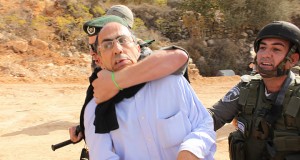by Alistair George 22 November 2011 | International Solidarity Movement, West Bank As thousands of Israeli settlers and Zionists crowded into Hebron on Friday night, November 19th, and Saturday for Shabbat Chaye Sarah – celebrating Abraham’s biblical purchase of land ...
Read More »Author Archives: Yara
An interview with Khaled Jarrar: Stamping Palestine into passports
by Alistair George 21 November 2011 | International Solidarity Movement, West Bank Khaled Jarrar is a Palestinian artist and photographer from Jenin, currently based in Ramallah. In addition to photographing and documenting the Israeli occupation, he has designed a ‘State ...
Read More »Hebron: Zionist paraders harass Palestinians, 7 internationals detained
by Alistair George and Ben Lorber 20 November 2011 | International Solidarity Movement, West Bank Over 1000 American and International Zionists joined 700 extremist settlers in Hebron this weekend to celebrate the reading of the Torah portion detailing Abraham’s biblical ...
Read More »Imneizil demolitions: “Hanging between the ground and the sky”
by Jenna Bereld 18 November 2011 | International Solidarity Movement, West Bank The solar panels in the village of Imneizil, near Hebron, became effective almost two years ago, improved the living conditions for about four hundred inhabitants in the village, ...
Read More »Internationals harassed and denied entry into Nabi Saleh
by Wahed Rejol 18 November 2011 | International Solidarity Movement, West Bank Following last week’s violence in the village of Nabi Saleh near Ramallah, international observers and activists were today denied entry into the village by Israeli soldiers. The soldiers ...
Read More »Al Baqa’a: The struggle of a family in the shadow of illegal annexation
by Alistair George 17 November 2011 | International Solidarity Movement, West Bank “The Israelis hope that that the young people leave, the old people die, and then they can confiscate the land and the houses” says Sami, an activist working ...
Read More »Freedom Riders: “I felt like I was witnessing history”
by Ben Lorber 15 November 2011 | International Solidarity Movement, West Bank Earlier today, 7 Palestinian activists were arrested as part of the Freedom Rides attempt to board segregated buses going from the West Bank into occupied East Jerusalem. Palestinians, ...
Read More »Freedom Riders: I witnessed six Palestinian activists demand freedom
by Holly 16 November 2011 | Carbonating Change Yesterday I witnessed six Palestinian activists demand freedom, justice and dignity as they defied Israel’s apartheid policies when the group successfully boarded settler-only buses and attempted to enter East Jerusalem, where they were ...
Read More »Al Qasab demolished as hundreds of Israeli soldiers watch
by Guillaume and William 15 November 2011 | International Solidarity Movement, West Bank This morning, on Tuesday 15th November, national day of Palestine, three houses in Al Qasab near Jericho were destroyed by the Israeli military. During the early morning, between ...
Read More »Jerusalem: Explosions, arrests and violence as Israel clears way for settlement activity
by Alistair George 13 November 2011 | International Solidarity Movement, West Bank Three Palestinians were arrested and others were detained, beaten and pepper sprayed by the Israeli military in Al-Walajeh yesterday, as villagers attempted to prevent the detonation of explosives ...
Read More » International Solidarity Movement Nonviolence. Justice. Freedom.
International Solidarity Movement Nonviolence. Justice. Freedom.






